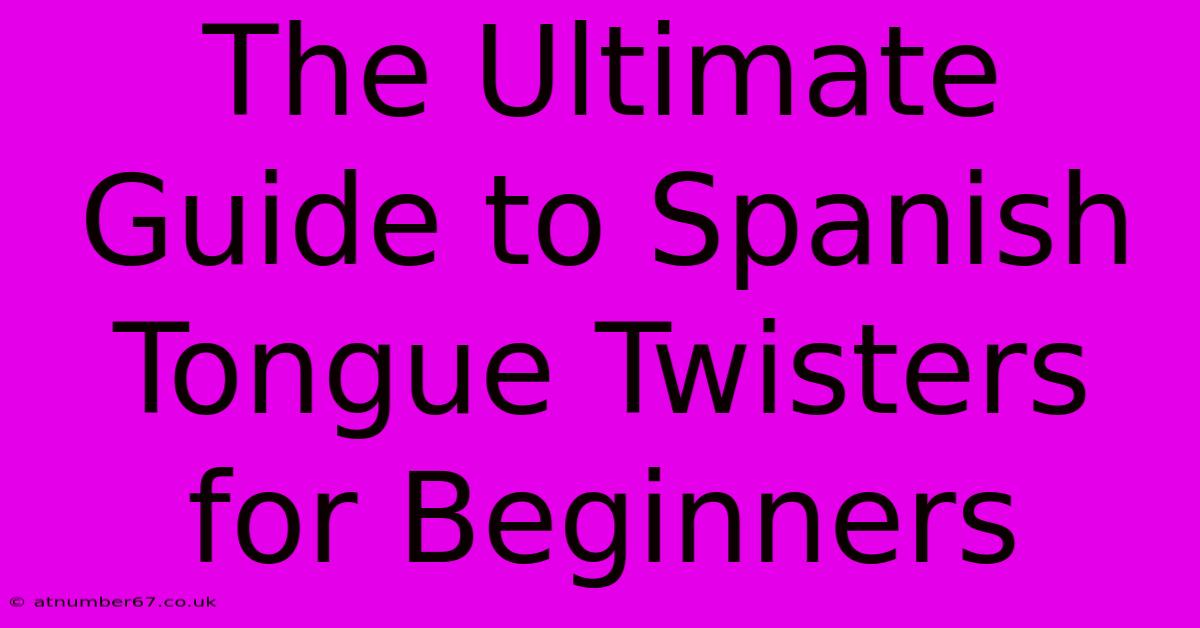The Ultimate Guide To Spanish Tongue Twisters For Beginners

Table of Contents
The Ultimate Guide to Spanish Tongue Twisters for Beginners
Learning a new language can be challenging, but it's also incredibly rewarding. And what better way to improve your pronunciation and fluency than with tongue twisters? Spanish, with its beautiful sounds and sometimes tricky pronunciations, is perfectly suited to this fun and effective learning method. This guide will equip you with a range of Spanish tongue twisters, categorized by difficulty, along with tips and tricks to master them.
Why Use Tongue Twisters to Learn Spanish?
Tongue twisters, or trabalenguas in Spanish, are more than just a fun game. They offer several significant benefits for language learners:
- Improved Pronunciation: Repeatedly saying the sounds in tongue twisters helps train your mouth muscles to produce the correct sounds and improves your overall pronunciation.
- Enhanced Fluency: The rhythmic repetition strengthens your muscle memory and helps you speak more smoothly and confidently.
- Increased Vocabulary: Many tongue twisters introduce new words and phrases organically, expanding your lexicon.
- Boosted Confidence: Successfully conquering a tongue twister boosts your morale and motivates you to tackle more challenging aspects of the language.
- Fun and Engaging: Learning should be enjoyable, and tongue twisters provide a lighthearted and entertaining way to practice.
Easy Spanish Tongue Twisters for Beginners
Let's start with some simple trabalenguas to ease you into the process. These focus on common sounds and basic sentence structures:
- "Pablito clavó un clavito." (Pablo hammered a little nail.) - This focuses on the "p" and "cl" sounds.
- "El perro de San Roque no tiene rabo." (The dog of San Roque doesn't have a tail.) - Practices the "r" sound and sentence rhythm.
- "Tres tristes tigres tragaban trigo en un trigal." (Three sad tigers were eating wheat in a wheat field.) - Great for practicing the "tr" sound.
Tips for Mastering Easy Tongue Twisters:
- Start slow: Don't rush. Focus on clear pronunciation, even if it's slow at first.
- Repeat often: Practice each twister multiple times a day.
- Record yourself: Listening back can help identify areas for improvement.
- Break it down: If a twister is too long, break it down into smaller phrases.
Intermediate Spanish Tongue Twisters
Once you've mastered the basics, you can move on to more challenging trabalenguas:
- "Si seiscientas seiscientas seis sillas, seiscientas seiscientas seis sillas son." (If six hundred and sixty-six chairs, six hundred and sixty-six chairs are.) - This twister tests your ability to rapidly pronounce similar-sounding numbers.
- "Dime, dulce dama, donde duermes, que en donde duermes duermo yo." (Tell me, sweet lady, where you sleep, for wherever you sleep I sleep too.) - This focuses on the rolling "r" sound and the interplay of vowels.
- "El que compra camisa de liencillo, con liencillo se limpia el bolsillo." (He who buys a linen shirt, wipes his pocket with linen.) - This twister practices difficult consonant combinations.
Tips for Mastering Intermediate Tongue Twisters:
- Focus on rhythm: Pay attention to the natural rhythm and flow of the sentence.
- Use a mirror: Watching your mouth movements can help you refine your pronunciation.
- Practice with a partner: Having someone else say the twister with you can help you stay motivated.
Advanced Spanish Tongue Twisters: A Challenge for the Bold
These trabalenguas are designed to push your skills to the limit. They incorporate complex sounds, rapid pronunciation, and tricky word combinations:
- "Pica, púa, Pablo, pica, púa." (Peck, spur, Pablo, peck, spur.) - Requires quick pronunciation of similar sounds.
- "Para que me quieras, te quiero a ti; para que te quiera yo, quiéreme a mí." (So that I may love you, I love you; so that you love me, love me.) - Tests mastery of different verb conjugations and intonation.
- "Erre con erre, cigarro; erre con erre, barril; rápido corren los carros, rápido corren y brillan." (R with r, cigar; r with r, barrel; the cars run quickly, they run quickly and shine.) - Masterclass in the tricky "r" sound and sentence flow.
Tips for Mastering Advanced Tongue Twisters:
- Slow and steady wins the race: Break the twister down into its smallest components and gradually increase speed.
- Listen to native speakers: Listen to how native Spanish speakers pronounce the twister to pick up on nuances.
- Embrace the challenge: Don't get discouraged if you don't master them immediately. Persistence is key.
Beyond the Twisters: Continuing Your Spanish Journey
Mastering Spanish tongue twisters is a great stepping stone to improving your overall fluency. Remember to combine this fun practice with other learning methods, such as:
- Immersion: Surround yourself with the language as much as possible.
- Conversation: Practice speaking with native speakers.
- Reading: Read Spanish books, articles, and news.
- Listening: Listen to Spanish music, podcasts, and audiobooks.
By consistently practicing and utilizing these techniques, you'll significantly enhance your Spanish language skills. ¡Buena suerte! (Good luck!)

Thank you for visiting our website wich cover about The Ultimate Guide To Spanish Tongue Twisters For Beginners. We hope the information provided has been useful to you. Feel free to contact us if you have any questions or need further assistance. See you next time and dont miss to bookmark.
Featured Posts
-
Gilded Age The Sound Of Silence
Apr 04, 2025
-
Rupert Lowes Net Worth Beyond Expectations
Apr 04, 2025
-
Your Guide To Understanding The Political World
Apr 04, 2025
-
The Son In Law They Underestimated
Apr 04, 2025
-
Ahmed Musa A Look Inside His Financial Life
Apr 04, 2025
